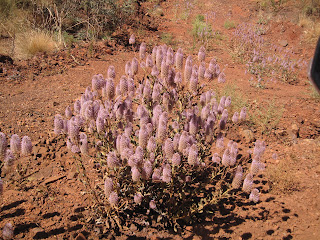After leaving Port Hedland, we headed inland for about 60 kms south to Indee Station and camped there for a couple of nights. This part of the Pilbara is pretty flat and open. The station had mustered cattle the day before we arrived and had them penned in the home yards. Next morning the animals were loaded onto trucks and shipped out.
The owners of the station (though I think most cattle runs in WA are leasehold), Colin and Betty, put on happy hour daily for staff and travellers - free nibbles provided, bring your own drinks - which is a good opportunity to chat with other campers. Few of the station staff were able to join us at that time as most were recovering from a severe viral illness, or otherwise occupied with cattle. Colin has had the station for 50 years and, at 74, also works two days a week in the mine. Camping facilities were basic, but adequate.
The main attraction at Indee Station is Red Rock where many ancient aboriginal petroglyphs can be seen. We found them difficult to locate, but after some time scrambling over the hot rock, we were eventually successful.
.jpg) |
Red Rock
View over Indee Station from Red Rock
View of campground from nearby hill |
Indee Station was also the site of a 1968 aeroplane crash in which 28 people died. A wing of the plane sheared off and crashed into the fuselage, evidently due to some creative but faulty aircraft maintenance in Perth. (
http://en.wikipedia.org/wiki/MacRobertson_Miller_Airlines_Flight_1750) There is a memorial to the crash victims near Red Rock together with bits and pieces of the wreckage.
Travelling inland further south along the Great Northern Highway, the flat terrain is increasingly dotted with low hills. There seems to be a mine located everywhere there is a low red hill or two. Road trains ply the road and a railway line runs mostly parallel to the road where trains of enormous length ferry their cargo of Pilbara rock to port. Dig it up and ship it out!
From the road we could see a few camps for miners - rows of dongas plonked down on the dirt under the blazing sun, and it's still winter here. I'm told they work 12 hour shifts with maybe one day off each month. Their accommnodation may be a room little larger than a walk in wardrobe with room for a bed, a small fridge and not much else. What a life!
KARAJINI NATIONAL PARK
We'd heard a lot about how fabulous Karajini was - best National Park in WA according to many - but driving in to the fairly flat, spinifex covered campground made me wonder what the fuss was about. Allocated a site on crushed red rock without any shade was not very encouraging either. However, it seems that Karajini is all about the gorges. Near Dales campground is Dales Gorge. A steep climb down (of course, it's a gorge) leads to Circular Pool, then further on, the pretty Fern Pool where maidenhair ferns grow wild. At the other end of this gorge is Fortescue Falls.
 |
Fern Pool
The eponymous vegetation
Fortescue Falls
Circular Pool |
There are no fossils in these rocks as they were formed from lava about 3.5 million years ago before there was life on earth. You just have to look at these rocks and you can pretty much see that they're full of iron. Try picking up even a small one and it's extremely heavy. There is also supposed to be asbestos in this gorge.
Forty-two kilometres along a teeth-chatteringly corrugated dirt road was the most spectacular gorge, series of gorges really, that we have ever seen. It made us wonder how breathtaking it must be to see the Grand Canyon.
The wildflowers were out, but those lining the road were covered in red dust and struggling to survive. I thought that by now I was an old hand when it came to dealing with red dust. Generally it just brushes off, but the red dust at Karijini was different, not the sort you could brush off, but the sort that stuck. We were all walking around with our clothes smeared with red dirt.
Driving west from Karijini, we crossed the Hammersley Range to Tom Price. The range is mostly made up of hills rounded by erosion, not as spectacular as the Kimberley perhaps, but interesting none the less.


























.jpg)
.jpg)
.jpg)
.jpg)
.jpg)
.jpg)



















